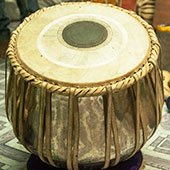Design Resource
Tabla Making - Varanasi
The Most Famous Rhythm Instrument
by
Prof. Bibhudutta Baral and Manasa K. H.
Meaning of Tabla:
TA: tabla or rhythm
B: Bola or words used
LA: Laya (speed, temp, or flow)
There is one opinion that in about 13th century Amir khusoro had invented sitar and tabla. The other version is that there was a rhythm instrument known as a tabla which used to be played during some special festivals, ceremonies and wars as a signal in Arabic region. Therefore, it is said that table is the result of Tabla.
Tabla is the most famous rhythm instrument in Indian Subcontinent, including India, Nepal, Pakistan and Afghanistan, Bangladesh and Srilanka. Tabla is known as a queen of drums and percussion instrument, it is the most popular Indian rhythm instrument. A complete set of tabla includes two drums. The right hand, smaller high–pitched drum is Dayan and the left hand, larger metal one called Bayan. These two instruments are almost always played together. Both drums have a body that is closed at the bottom.
Craftsman Babu says from the age of 8 years, he is in tabla making. He has learned tabla making from his grandfather, Nehmath Ullah and it is their family business.
Bayan:
The Bayan takes on the bass pat of the drum duo. The body of the Bayan is mostly made of Brass. The Bayan is played by the index finger and middle finger of the left hand in turn or with both fingers simultaneously. While doing this, the ball of the thumb rests lightly on the edge of the skin or modulates the pitch by slightly pressing the skin.
Parts of Bayan
• Maidan
• Syahi
• Gajara
• Baddhi
• Aadhar
• Chatti
• Kuri
The Dayan:
Dayan’s are made of different varieties of wood. The most used and well-known wood types are shrisham, Neem, Mahogany and Babla Wood. The tuning wedges that are held by leather straps at the sides are meant for tuning the instrument. Depending on whether the wedges are beaten upwards or downwards by the tuning hammer, the sound gets lower or higher. A fine-tuning is done by beating with the tuning hammer on the woven ring around the skin. The size of a Dayan is defined by the diameter of the skin. Sizes of 5 to 6 inches are in use. The standard sizes are about 5 1/4 inches to 5 1/2 inches whose tuning is around C.The measurements can also be given in centimeters. The tuning of the Dayan is also depends on the skin diameter. The smaller the skin is, the higher is the sound of the Dayan; the bigger the skin diameter, the lower it can be tuned. Specially low or high Dayan is played together with corresponding high or low melody instruments.
Parts of Dayan
• Maidan
• Syahi
• Gajara
• Gatta
• Aadhar
• Chatti
• Lakri




